Experiential Open Innovation and Co-creation Report: Analysis
VerifiedAdded on 2023/03/30
|9
|1867
|457
Report
AI Summary
This report delves into the concepts of open innovation and co-creation, examining their definitions, applications, and implications in business organizations. It discusses various models of crowdsourced innovation, including crowdsourced competition, community-based competition, and open-source co-innovation, highlighting examples such as Innocentive, Threadless, and Linux. The report explores the role of online platforms in facilitating open innovation and co-creation, referencing studies on the SAPiens community and visualizations of management reviews. It also addresses the challenges and risks associated with integrating customers into innovation processes and emphasizes the importance of balancing collaboration and competition. The report concludes by underscoring the significance of co-creation and open innovation in fostering mutual value among retailers, designers, suppliers, and customers, using Caterpillar as a case study to illustrate the practical application of these strategies.
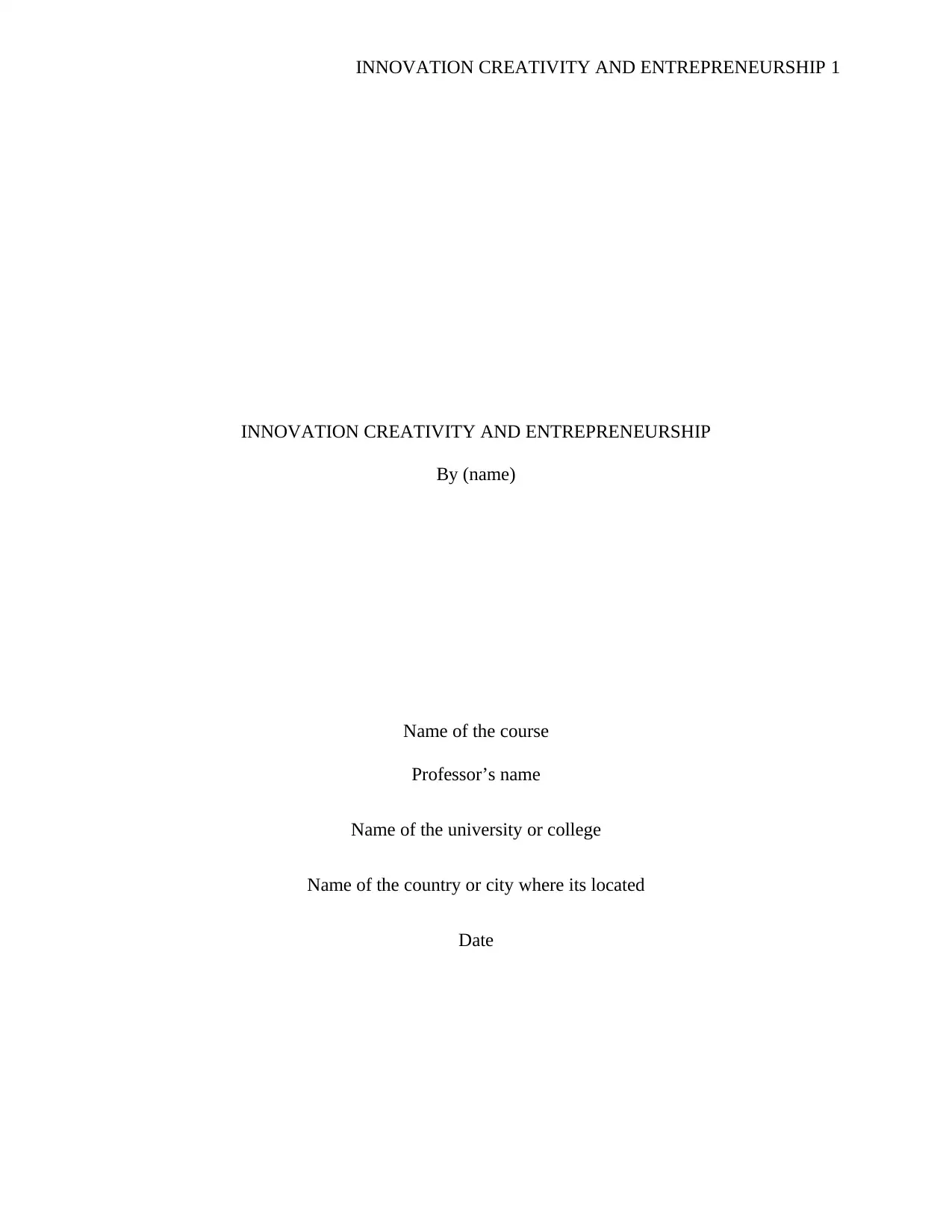
INNOVATION CREATIVITY AND ENTREPRENEURSHIP 1
INNOVATION CREATIVITY AND ENTREPRENEURSHIP
By (name)
Name of the course
Professor’s name
Name of the university or college
Name of the country or city where its located
Date
INNOVATION CREATIVITY AND ENTREPRENEURSHIP
By (name)
Name of the course
Professor’s name
Name of the university or college
Name of the country or city where its located
Date
Paraphrase This Document
Need a fresh take? Get an instant paraphrase of this document with our AI Paraphraser
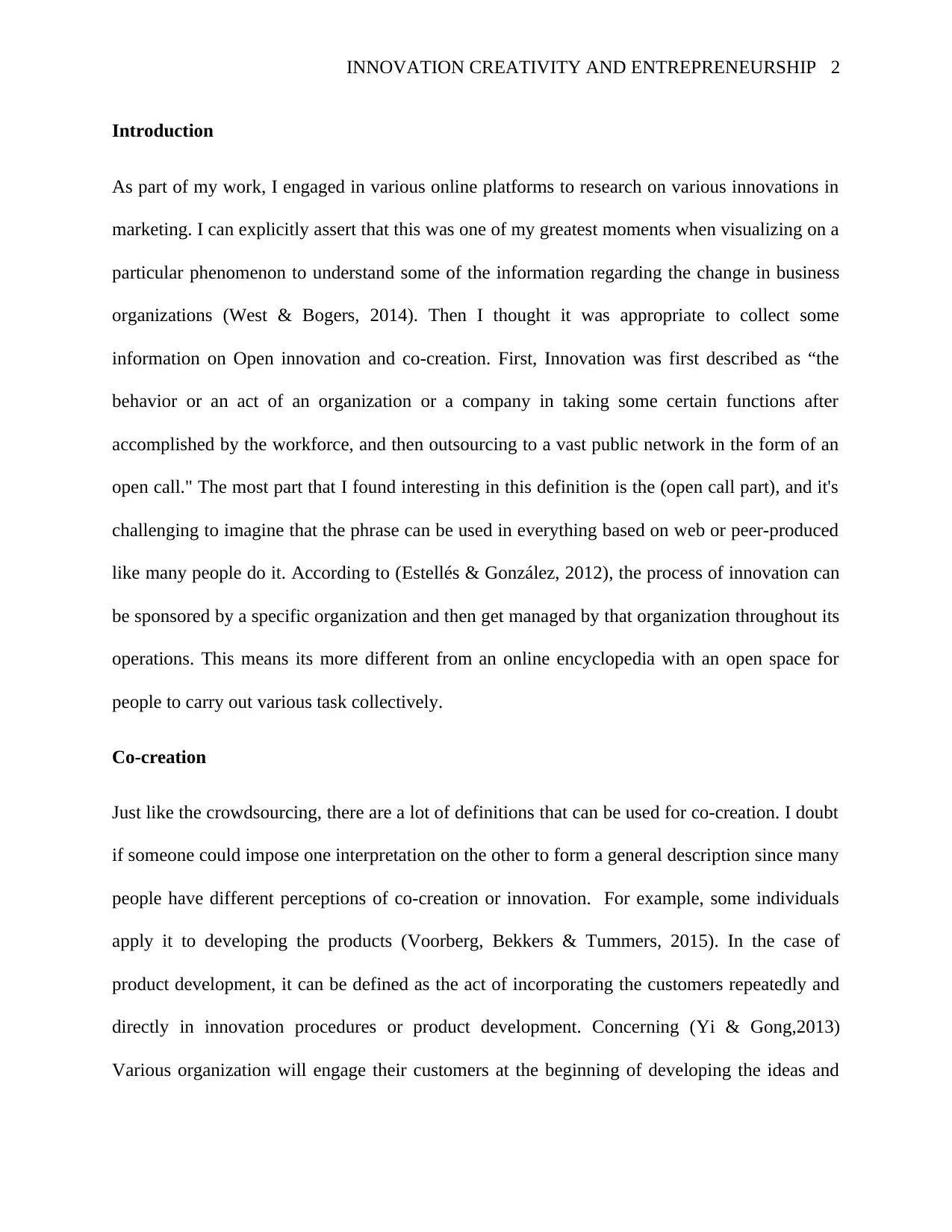
INNOVATION CREATIVITY AND ENTREPRENEURSHIP 2
Introduction
As part of my work, I engaged in various online platforms to research on various innovations in
marketing. I can explicitly assert that this was one of my greatest moments when visualizing on a
particular phenomenon to understand some of the information regarding the change in business
organizations (West & Bogers, 2014). Then I thought it was appropriate to collect some
information on Open innovation and co-creation. First, Innovation was first described as “the
behavior or an act of an organization or a company in taking some certain functions after
accomplished by the workforce, and then outsourcing to a vast public network in the form of an
open call." The most part that I found interesting in this definition is the (open call part), and it's
challenging to imagine that the phrase can be used in everything based on web or peer-produced
like many people do it. According to (Estellés & González, 2012), the process of innovation can
be sponsored by a specific organization and then get managed by that organization throughout its
operations. This means its more different from an online encyclopedia with an open space for
people to carry out various task collectively.
Co-creation
Just like the crowdsourcing, there are a lot of definitions that can be used for co-creation. I doubt
if someone could impose one interpretation on the other to form a general description since many
people have different perceptions of co-creation or innovation. For example, some individuals
apply it to developing the products (Voorberg, Bekkers & Tummers, 2015). In the case of
product development, it can be defined as the act of incorporating the customers repeatedly and
directly in innovation procedures or product development. Concerning (Yi & Gong,2013)
Various organization will engage their customers at the beginning of developing the ideas and
Introduction
As part of my work, I engaged in various online platforms to research on various innovations in
marketing. I can explicitly assert that this was one of my greatest moments when visualizing on a
particular phenomenon to understand some of the information regarding the change in business
organizations (West & Bogers, 2014). Then I thought it was appropriate to collect some
information on Open innovation and co-creation. First, Innovation was first described as “the
behavior or an act of an organization or a company in taking some certain functions after
accomplished by the workforce, and then outsourcing to a vast public network in the form of an
open call." The most part that I found interesting in this definition is the (open call part), and it's
challenging to imagine that the phrase can be used in everything based on web or peer-produced
like many people do it. According to (Estellés & González, 2012), the process of innovation can
be sponsored by a specific organization and then get managed by that organization throughout its
operations. This means its more different from an online encyclopedia with an open space for
people to carry out various task collectively.
Co-creation
Just like the crowdsourcing, there are a lot of definitions that can be used for co-creation. I doubt
if someone could impose one interpretation on the other to form a general description since many
people have different perceptions of co-creation or innovation. For example, some individuals
apply it to developing the products (Voorberg, Bekkers & Tummers, 2015). In the case of
product development, it can be defined as the act of incorporating the customers repeatedly and
directly in innovation procedures or product development. Concerning (Yi & Gong,2013)
Various organization will engage their customers at the beginning of developing the ideas and
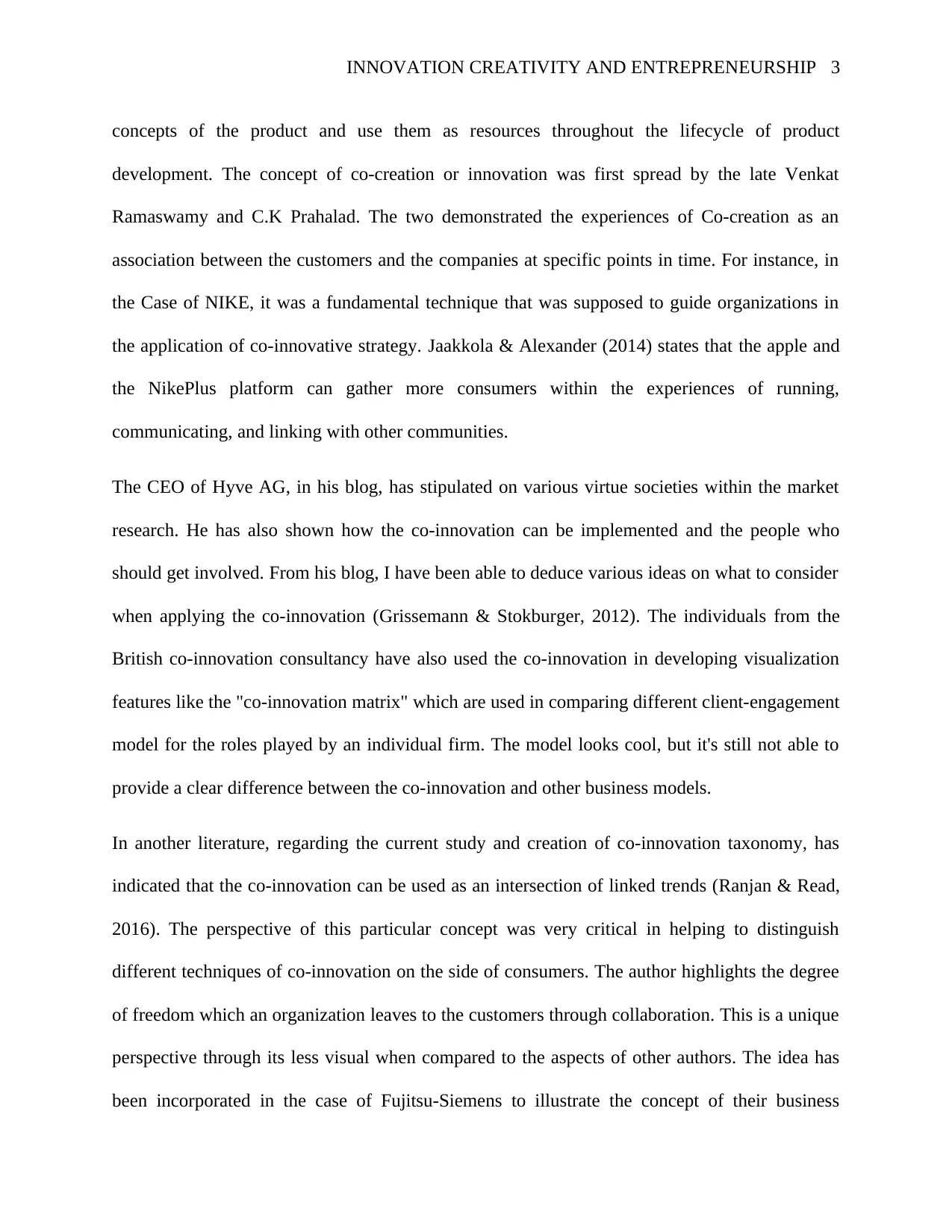
INNOVATION CREATIVITY AND ENTREPRENEURSHIP 3
concepts of the product and use them as resources throughout the lifecycle of product
development. The concept of co-creation or innovation was first spread by the late Venkat
Ramaswamy and C.K Prahalad. The two demonstrated the experiences of Co-creation as an
association between the customers and the companies at specific points in time. For instance, in
the Case of NIKE, it was a fundamental technique that was supposed to guide organizations in
the application of co-innovative strategy. Jaakkola & Alexander (2014) states that the apple and
the NikePlus platform can gather more consumers within the experiences of running,
communicating, and linking with other communities.
The CEO of Hyve AG, in his blog, has stipulated on various virtue societies within the market
research. He has also shown how the co-innovation can be implemented and the people who
should get involved. From his blog, I have been able to deduce various ideas on what to consider
when applying the co-innovation (Grissemann & Stokburger, 2012). The individuals from the
British co-innovation consultancy have also used the co-innovation in developing visualization
features like the "co-innovation matrix" which are used in comparing different client-engagement
model for the roles played by an individual firm. The model looks cool, but it's still not able to
provide a clear difference between the co-innovation and other business models.
In another literature, regarding the current study and creation of co-innovation taxonomy, has
indicated that the co-innovation can be used as an intersection of linked trends (Ranjan & Read,
2016). The perspective of this particular concept was very critical in helping to distinguish
different techniques of co-innovation on the side of consumers. The author highlights the degree
of freedom which an organization leaves to the customers through collaboration. This is a unique
perspective through its less visual when compared to the aspects of other authors. The idea has
been incorporated in the case of Fujitsu-Siemens to illustrate the concept of their business
concepts of the product and use them as resources throughout the lifecycle of product
development. The concept of co-creation or innovation was first spread by the late Venkat
Ramaswamy and C.K Prahalad. The two demonstrated the experiences of Co-creation as an
association between the customers and the companies at specific points in time. For instance, in
the Case of NIKE, it was a fundamental technique that was supposed to guide organizations in
the application of co-innovative strategy. Jaakkola & Alexander (2014) states that the apple and
the NikePlus platform can gather more consumers within the experiences of running,
communicating, and linking with other communities.
The CEO of Hyve AG, in his blog, has stipulated on various virtue societies within the market
research. He has also shown how the co-innovation can be implemented and the people who
should get involved. From his blog, I have been able to deduce various ideas on what to consider
when applying the co-innovation (Grissemann & Stokburger, 2012). The individuals from the
British co-innovation consultancy have also used the co-innovation in developing visualization
features like the "co-innovation matrix" which are used in comparing different client-engagement
model for the roles played by an individual firm. The model looks cool, but it's still not able to
provide a clear difference between the co-innovation and other business models.
In another literature, regarding the current study and creation of co-innovation taxonomy, has
indicated that the co-innovation can be used as an intersection of linked trends (Ranjan & Read,
2016). The perspective of this particular concept was very critical in helping to distinguish
different techniques of co-innovation on the side of consumers. The author highlights the degree
of freedom which an organization leaves to the customers through collaboration. This is a unique
perspective through its less visual when compared to the aspects of other authors. The idea has
been incorporated in the case of Fujitsu-Siemens to illustrate the concept of their business
⊘ This is a preview!⊘
Do you want full access?
Subscribe today to unlock all pages.

Trusted by 1+ million students worldwide
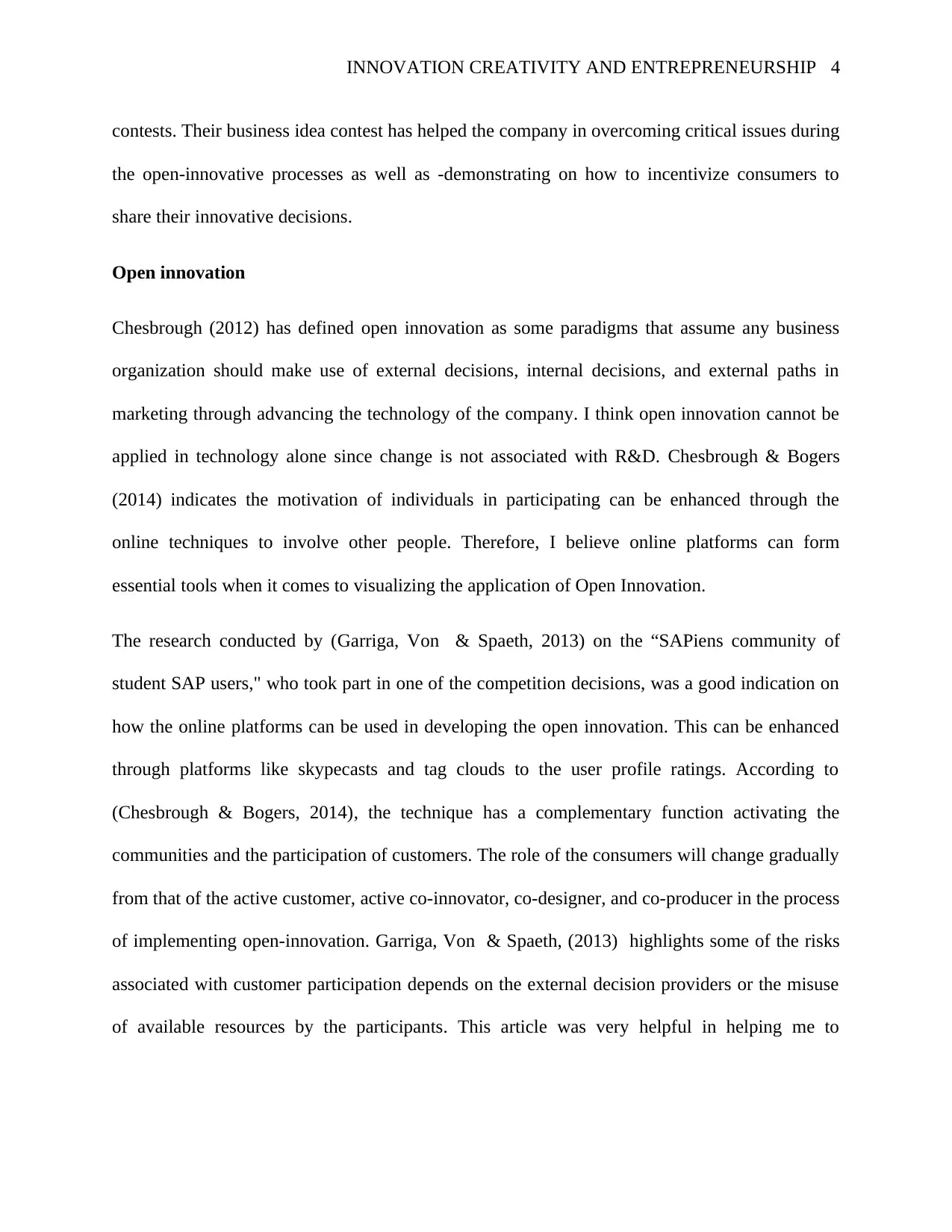
INNOVATION CREATIVITY AND ENTREPRENEURSHIP 4
contests. Their business idea contest has helped the company in overcoming critical issues during
the open-innovative processes as well as -demonstrating on how to incentivize consumers to
share their innovative decisions.
Open innovation
Chesbrough (2012) has defined open innovation as some paradigms that assume any business
organization should make use of external decisions, internal decisions, and external paths in
marketing through advancing the technology of the company. I think open innovation cannot be
applied in technology alone since change is not associated with R&D. Chesbrough & Bogers
(2014) indicates the motivation of individuals in participating can be enhanced through the
online techniques to involve other people. Therefore, I believe online platforms can form
essential tools when it comes to visualizing the application of Open Innovation.
The research conducted by (Garriga, Von & Spaeth, 2013) on the “SAPiens community of
student SAP users," who took part in one of the competition decisions, was a good indication on
how the online platforms can be used in developing the open innovation. This can be enhanced
through platforms like skypecasts and tag clouds to the user profile ratings. According to
(Chesbrough & Bogers, 2014), the technique has a complementary function activating the
communities and the participation of customers. The role of the consumers will change gradually
from that of the active customer, active co-innovator, co-designer, and co-producer in the process
of implementing open-innovation. Garriga, Von & Spaeth, (2013) highlights some of the risks
associated with customer participation depends on the external decision providers or the misuse
of available resources by the participants. This article was very helpful in helping me to
contests. Their business idea contest has helped the company in overcoming critical issues during
the open-innovative processes as well as -demonstrating on how to incentivize consumers to
share their innovative decisions.
Open innovation
Chesbrough (2012) has defined open innovation as some paradigms that assume any business
organization should make use of external decisions, internal decisions, and external paths in
marketing through advancing the technology of the company. I think open innovation cannot be
applied in technology alone since change is not associated with R&D. Chesbrough & Bogers
(2014) indicates the motivation of individuals in participating can be enhanced through the
online techniques to involve other people. Therefore, I believe online platforms can form
essential tools when it comes to visualizing the application of Open Innovation.
The research conducted by (Garriga, Von & Spaeth, 2013) on the “SAPiens community of
student SAP users," who took part in one of the competition decisions, was a good indication on
how the online platforms can be used in developing the open innovation. This can be enhanced
through platforms like skypecasts and tag clouds to the user profile ratings. According to
(Chesbrough & Bogers, 2014), the technique has a complementary function activating the
communities and the participation of customers. The role of the consumers will change gradually
from that of the active customer, active co-innovator, co-designer, and co-producer in the process
of implementing open-innovation. Garriga, Von & Spaeth, (2013) highlights some of the risks
associated with customer participation depends on the external decision providers or the misuse
of available resources by the participants. This article was very helpful in helping me to
Paraphrase This Document
Need a fresh take? Get an instant paraphrase of this document with our AI Paraphraser
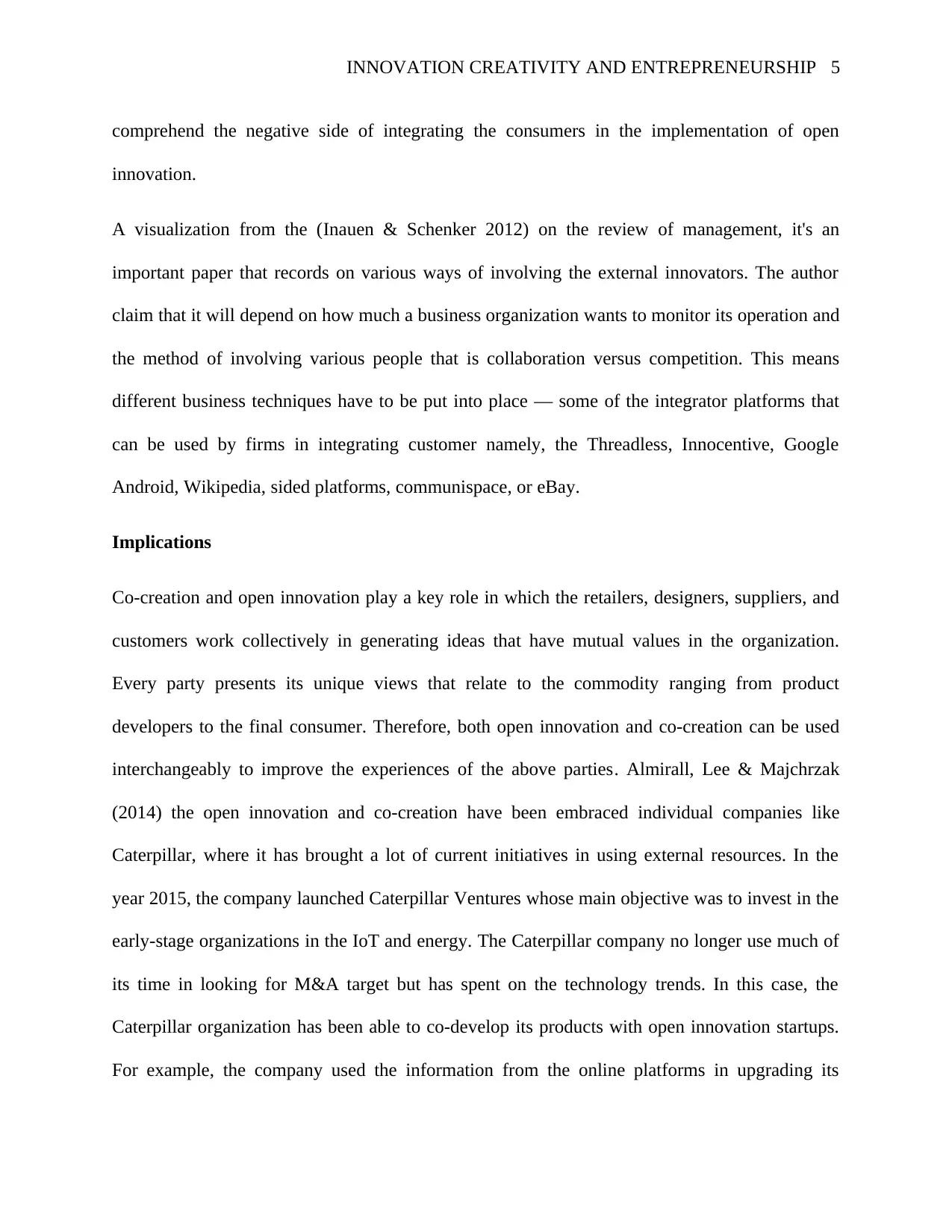
INNOVATION CREATIVITY AND ENTREPRENEURSHIP 5
comprehend the negative side of integrating the consumers in the implementation of open
innovation.
A visualization from the (Inauen & Schenker 2012) on the review of management, it's an
important paper that records on various ways of involving the external innovators. The author
claim that it will depend on how much a business organization wants to monitor its operation and
the method of involving various people that is collaboration versus competition. This means
different business techniques have to be put into place — some of the integrator platforms that
can be used by firms in integrating customer namely, the Threadless, Innocentive, Google
Android, Wikipedia, sided platforms, communispace, or eBay.
Implications
Co-creation and open innovation play a key role in which the retailers, designers, suppliers, and
customers work collectively in generating ideas that have mutual values in the organization.
Every party presents its unique views that relate to the commodity ranging from product
developers to the final consumer. Therefore, both open innovation and co-creation can be used
interchangeably to improve the experiences of the above parties. Almirall, Lee & Majchrzak
(2014) the open innovation and co-creation have been embraced individual companies like
Caterpillar, where it has brought a lot of current initiatives in using external resources. In the
year 2015, the company launched Caterpillar Ventures whose main objective was to invest in the
early-stage organizations in the IoT and energy. The Caterpillar company no longer use much of
its time in looking for M&A target but has spent on the technology trends. In this case, the
Caterpillar organization has been able to co-develop its products with open innovation startups.
For example, the company used the information from the online platforms in upgrading its
comprehend the negative side of integrating the consumers in the implementation of open
innovation.
A visualization from the (Inauen & Schenker 2012) on the review of management, it's an
important paper that records on various ways of involving the external innovators. The author
claim that it will depend on how much a business organization wants to monitor its operation and
the method of involving various people that is collaboration versus competition. This means
different business techniques have to be put into place — some of the integrator platforms that
can be used by firms in integrating customer namely, the Threadless, Innocentive, Google
Android, Wikipedia, sided platforms, communispace, or eBay.
Implications
Co-creation and open innovation play a key role in which the retailers, designers, suppliers, and
customers work collectively in generating ideas that have mutual values in the organization.
Every party presents its unique views that relate to the commodity ranging from product
developers to the final consumer. Therefore, both open innovation and co-creation can be used
interchangeably to improve the experiences of the above parties. Almirall, Lee & Majchrzak
(2014) the open innovation and co-creation have been embraced individual companies like
Caterpillar, where it has brought a lot of current initiatives in using external resources. In the
year 2015, the company launched Caterpillar Ventures whose main objective was to invest in the
early-stage organizations in the IoT and energy. The Caterpillar company no longer use much of
its time in looking for M&A target but has spent on the technology trends. In this case, the
Caterpillar organization has been able to co-develop its products with open innovation startups.
For example, the company used the information from the online platforms in upgrading its
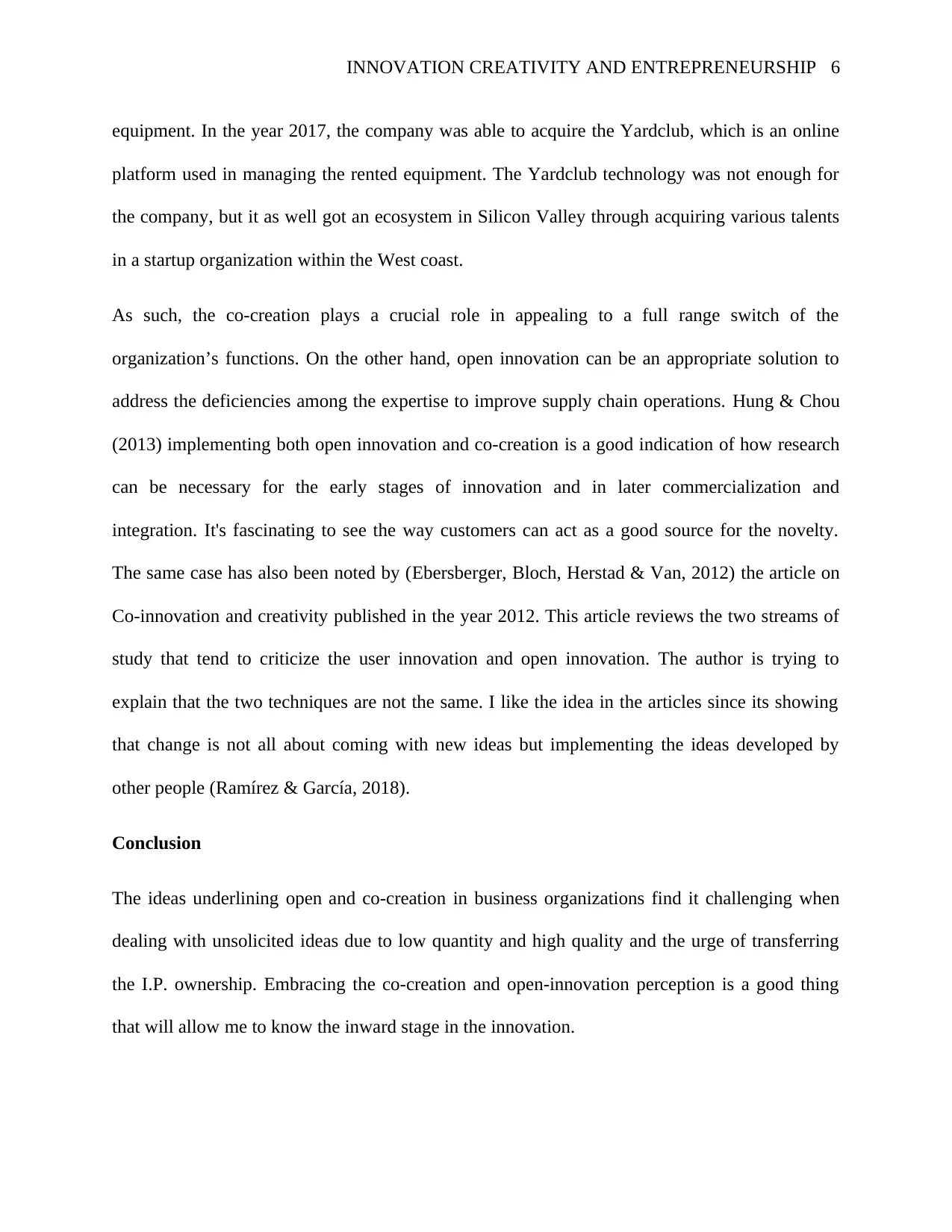
INNOVATION CREATIVITY AND ENTREPRENEURSHIP 6
equipment. In the year 2017, the company was able to acquire the Yardclub, which is an online
platform used in managing the rented equipment. The Yardclub technology was not enough for
the company, but it as well got an ecosystem in Silicon Valley through acquiring various talents
in a startup organization within the West coast.
As such, the co-creation plays a crucial role in appealing to a full range switch of the
organization’s functions. On the other hand, open innovation can be an appropriate solution to
address the deficiencies among the expertise to improve supply chain operations. Hung & Chou
(2013) implementing both open innovation and co-creation is a good indication of how research
can be necessary for the early stages of innovation and in later commercialization and
integration. It's fascinating to see the way customers can act as a good source for the novelty.
The same case has also been noted by (Ebersberger, Bloch, Herstad & Van, 2012) the article on
Co-innovation and creativity published in the year 2012. This article reviews the two streams of
study that tend to criticize the user innovation and open innovation. The author is trying to
explain that the two techniques are not the same. I like the idea in the articles since its showing
that change is not all about coming with new ideas but implementing the ideas developed by
other people (Ramírez & García, 2018).
Conclusion
The ideas underlining open and co-creation in business organizations find it challenging when
dealing with unsolicited ideas due to low quantity and high quality and the urge of transferring
the I.P. ownership. Embracing the co-creation and open-innovation perception is a good thing
that will allow me to know the inward stage in the innovation.
equipment. In the year 2017, the company was able to acquire the Yardclub, which is an online
platform used in managing the rented equipment. The Yardclub technology was not enough for
the company, but it as well got an ecosystem in Silicon Valley through acquiring various talents
in a startup organization within the West coast.
As such, the co-creation plays a crucial role in appealing to a full range switch of the
organization’s functions. On the other hand, open innovation can be an appropriate solution to
address the deficiencies among the expertise to improve supply chain operations. Hung & Chou
(2013) implementing both open innovation and co-creation is a good indication of how research
can be necessary for the early stages of innovation and in later commercialization and
integration. It's fascinating to see the way customers can act as a good source for the novelty.
The same case has also been noted by (Ebersberger, Bloch, Herstad & Van, 2012) the article on
Co-innovation and creativity published in the year 2012. This article reviews the two streams of
study that tend to criticize the user innovation and open innovation. The author is trying to
explain that the two techniques are not the same. I like the idea in the articles since its showing
that change is not all about coming with new ideas but implementing the ideas developed by
other people (Ramírez & García, 2018).
Conclusion
The ideas underlining open and co-creation in business organizations find it challenging when
dealing with unsolicited ideas due to low quantity and high quality and the urge of transferring
the I.P. ownership. Embracing the co-creation and open-innovation perception is a good thing
that will allow me to know the inward stage in the innovation.
⊘ This is a preview!⊘
Do you want full access?
Subscribe today to unlock all pages.

Trusted by 1+ million students worldwide
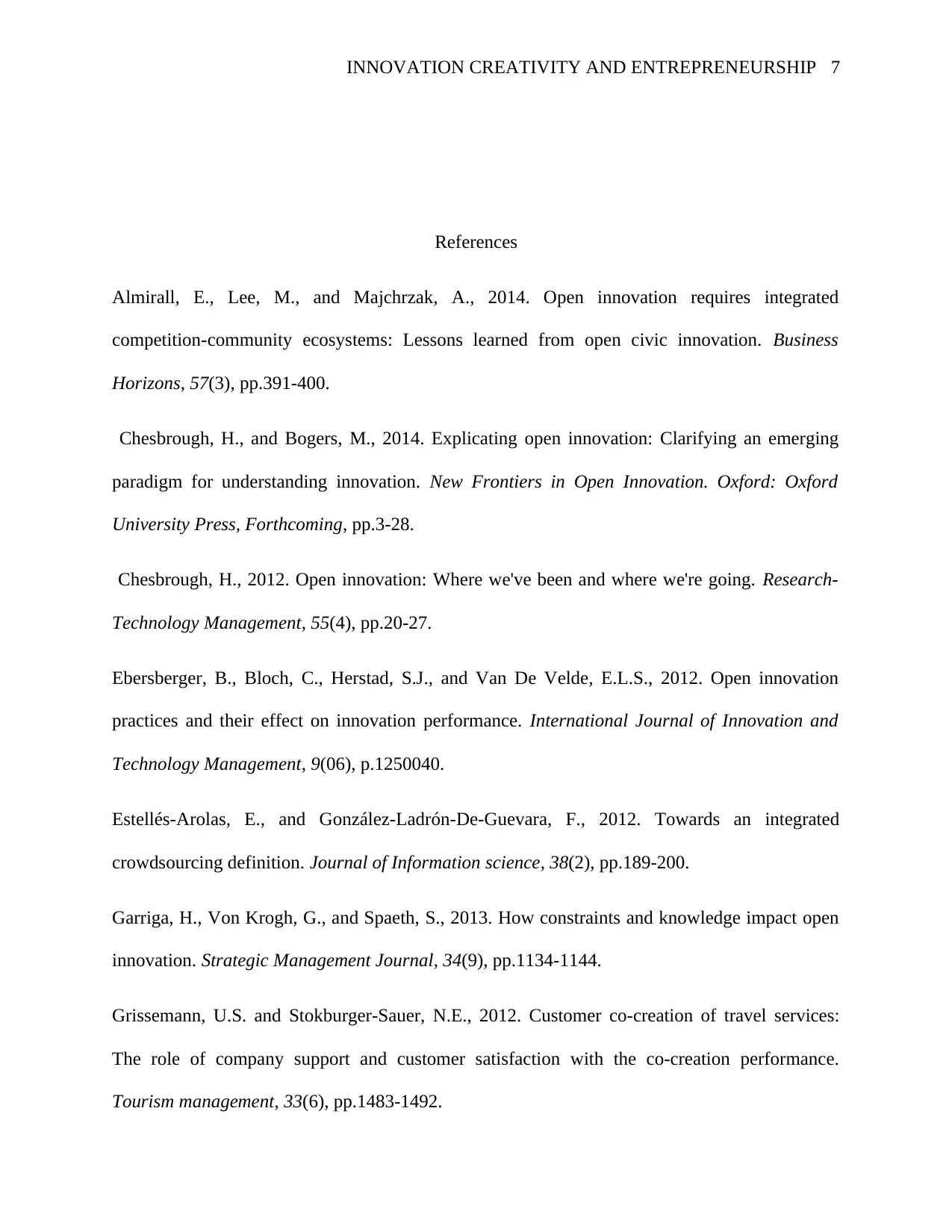
INNOVATION CREATIVITY AND ENTREPRENEURSHIP 7
References
Almirall, E., Lee, M., and Majchrzak, A., 2014. Open innovation requires integrated
competition-community ecosystems: Lessons learned from open civic innovation. Business
Horizons, 57(3), pp.391-400.
Chesbrough, H., and Bogers, M., 2014. Explicating open innovation: Clarifying an emerging
paradigm for understanding innovation. New Frontiers in Open Innovation. Oxford: Oxford
University Press, Forthcoming, pp.3-28.
Chesbrough, H., 2012. Open innovation: Where we've been and where we're going. Research-
Technology Management, 55(4), pp.20-27.
Ebersberger, B., Bloch, C., Herstad, S.J., and Van De Velde, E.L.S., 2012. Open innovation
practices and their effect on innovation performance. International Journal of Innovation and
Technology Management, 9(06), p.1250040.
Estellés-Arolas, E., and González-Ladrón-De-Guevara, F., 2012. Towards an integrated
crowdsourcing definition. Journal of Information science, 38(2), pp.189-200.
Garriga, H., Von Krogh, G., and Spaeth, S., 2013. How constraints and knowledge impact open
innovation. Strategic Management Journal, 34(9), pp.1134-1144.
Grissemann, U.S. and Stokburger-Sauer, N.E., 2012. Customer co-creation of travel services:
The role of company support and customer satisfaction with the co-creation performance.
Tourism management, 33(6), pp.1483-1492.
References
Almirall, E., Lee, M., and Majchrzak, A., 2014. Open innovation requires integrated
competition-community ecosystems: Lessons learned from open civic innovation. Business
Horizons, 57(3), pp.391-400.
Chesbrough, H., and Bogers, M., 2014. Explicating open innovation: Clarifying an emerging
paradigm for understanding innovation. New Frontiers in Open Innovation. Oxford: Oxford
University Press, Forthcoming, pp.3-28.
Chesbrough, H., 2012. Open innovation: Where we've been and where we're going. Research-
Technology Management, 55(4), pp.20-27.
Ebersberger, B., Bloch, C., Herstad, S.J., and Van De Velde, E.L.S., 2012. Open innovation
practices and their effect on innovation performance. International Journal of Innovation and
Technology Management, 9(06), p.1250040.
Estellés-Arolas, E., and González-Ladrón-De-Guevara, F., 2012. Towards an integrated
crowdsourcing definition. Journal of Information science, 38(2), pp.189-200.
Garriga, H., Von Krogh, G., and Spaeth, S., 2013. How constraints and knowledge impact open
innovation. Strategic Management Journal, 34(9), pp.1134-1144.
Grissemann, U.S. and Stokburger-Sauer, N.E., 2012. Customer co-creation of travel services:
The role of company support and customer satisfaction with the co-creation performance.
Tourism management, 33(6), pp.1483-1492.
Paraphrase This Document
Need a fresh take? Get an instant paraphrase of this document with our AI Paraphraser
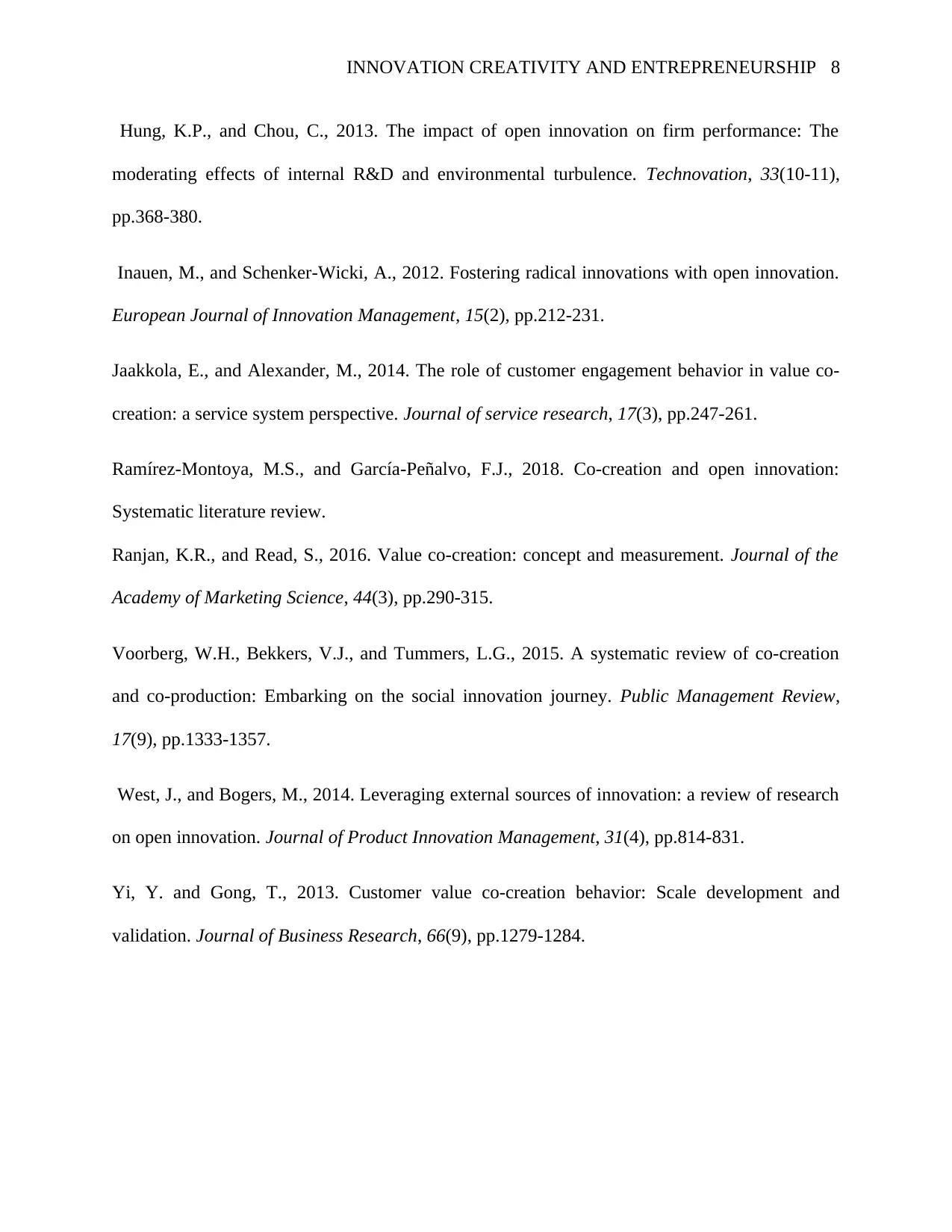
INNOVATION CREATIVITY AND ENTREPRENEURSHIP 8
Hung, K.P., and Chou, C., 2013. The impact of open innovation on firm performance: The
moderating effects of internal R&D and environmental turbulence. Technovation, 33(10-11),
pp.368-380.
Inauen, M., and Schenker-Wicki, A., 2012. Fostering radical innovations with open innovation.
European Journal of Innovation Management, 15(2), pp.212-231.
Jaakkola, E., and Alexander, M., 2014. The role of customer engagement behavior in value co-
creation: a service system perspective. Journal of service research, 17(3), pp.247-261.
Ramírez-Montoya, M.S., and García-Peñalvo, F.J., 2018. Co-creation and open innovation:
Systematic literature review.
Ranjan, K.R., and Read, S., 2016. Value co-creation: concept and measurement. Journal of the
Academy of Marketing Science, 44(3), pp.290-315.
Voorberg, W.H., Bekkers, V.J., and Tummers, L.G., 2015. A systematic review of co-creation
and co-production: Embarking on the social innovation journey. Public Management Review,
17(9), pp.1333-1357.
West, J., and Bogers, M., 2014. Leveraging external sources of innovation: a review of research
on open innovation. Journal of Product Innovation Management, 31(4), pp.814-831.
Yi, Y. and Gong, T., 2013. Customer value co-creation behavior: Scale development and
validation. Journal of Business Research, 66(9), pp.1279-1284.
Hung, K.P., and Chou, C., 2013. The impact of open innovation on firm performance: The
moderating effects of internal R&D and environmental turbulence. Technovation, 33(10-11),
pp.368-380.
Inauen, M., and Schenker-Wicki, A., 2012. Fostering radical innovations with open innovation.
European Journal of Innovation Management, 15(2), pp.212-231.
Jaakkola, E., and Alexander, M., 2014. The role of customer engagement behavior in value co-
creation: a service system perspective. Journal of service research, 17(3), pp.247-261.
Ramírez-Montoya, M.S., and García-Peñalvo, F.J., 2018. Co-creation and open innovation:
Systematic literature review.
Ranjan, K.R., and Read, S., 2016. Value co-creation: concept and measurement. Journal of the
Academy of Marketing Science, 44(3), pp.290-315.
Voorberg, W.H., Bekkers, V.J., and Tummers, L.G., 2015. A systematic review of co-creation
and co-production: Embarking on the social innovation journey. Public Management Review,
17(9), pp.1333-1357.
West, J., and Bogers, M., 2014. Leveraging external sources of innovation: a review of research
on open innovation. Journal of Product Innovation Management, 31(4), pp.814-831.
Yi, Y. and Gong, T., 2013. Customer value co-creation behavior: Scale development and
validation. Journal of Business Research, 66(9), pp.1279-1284.

INNOVATION CREATIVITY AND ENTREPRENEURSHIP 9
⊘ This is a preview!⊘
Do you want full access?
Subscribe today to unlock all pages.

Trusted by 1+ million students worldwide
1 out of 9
Related Documents
Your All-in-One AI-Powered Toolkit for Academic Success.
+13062052269
info@desklib.com
Available 24*7 on WhatsApp / Email
![[object Object]](/_next/static/media/star-bottom.7253800d.svg)
Unlock your academic potential
Copyright © 2020–2025 A2Z Services. All Rights Reserved. Developed and managed by ZUCOL.





